
A View Inside North Korea
As featured in The Washington Post “Markets helping North Koreans become more independent of the regime, poll says” on July 24, 2017.
Key Findings
- 35 of 36 North Korean respondents said at least 75% of their household income came from markets.
- 72% of North Korean respondents (26 of 36) said they received almost all of their household income from markets.
- 21 of 30 respondents, or 70%, who said the outside world had a greater influence on their lives than North Korean government decisions said they received almost all of their household income from markets.
- A higher percentage of female than male respondents said low salaries or currency/market interference caused them to feel the greatest animosity toward the North Korean government.
- Respondents in provinces further away from the China-North Korea border were as likely as those proximate to China to state that almost all of their income came from markets rather than the government.
In North Korea, the government controls the labor market and sets income levels. The government’s State Planning Committee is in charge of determining the number of jobs available in each economic sector. The government then decides who gets what jobs and what wages they will be paid. In fact, Article 5 of North Korea’s Labor Laws actually guarantees all workers will have jobs. 1
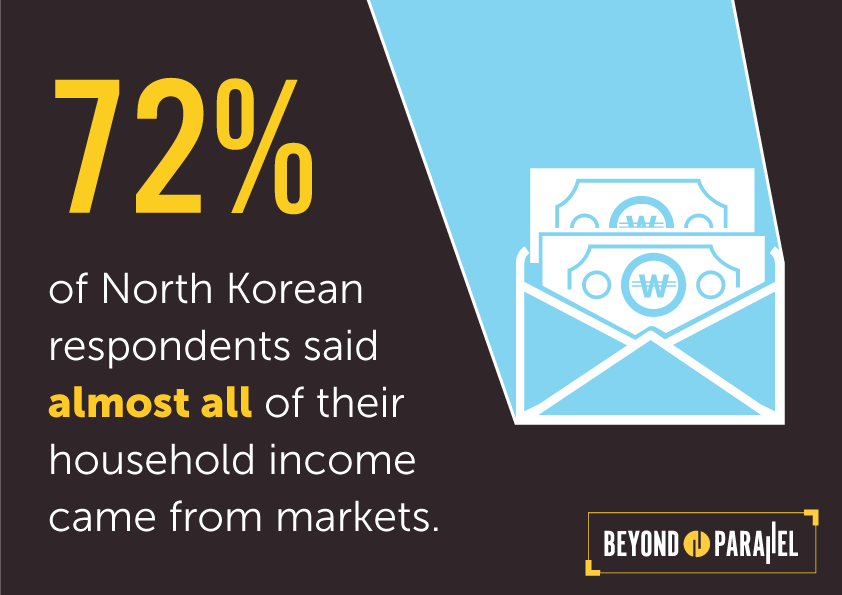
What percentage of your household income is derived from the markets?
| Percent of Household Income | Number of Respondents |
|---|---|
| Almost All | 26 |
| More Than 75% | 9 |
| About 50%-70% | 1 |
| About 25%-50%% | 0 |
| About 10%-25% | 0 |
| Less than 10% | 0 |
| None | 0 |
A bi-annual survey of North Koreans living in Seoul conducted by Seoul National University (SNU) found that 75.3% of respondents in 2015 thought 70% or more of the people in North Korea were engaged in market activities or personal businesses. Roughly, one third of the respondents interviewed by SNU believed 90% or more of people were involved in such activities. 2
What percent of North Koreans do you think are engaged in market activities or personal businesses?
| Respondents | 90% or more | 80% | 70% | 60% | 50% | 40% | 30% | 20% | Less than 10% |
|---|---|---|---|---|---|---|---|---|---|
| Percent of Male Respondents | 19.3 | 31.6 | 14.5 | 10.5 | 7.0 | 7.0 | 5.3 | 1.8 | 0.0 |
| Percent of Female Respondents | 32.6 | 30.3 | 16.9 | 7.9 | 6.7 | 2.2 | 1.1 | 0.0 | 2.2 |
| Percent of Total Respondents | 27.4 | 30.8 | 17.1 | 8.9 | 6.8 | 4.1 | 2.7 | 0.7 | 1.4 |
Source: North Korean Public Perception on Unification 2015(북한주민 통일의식 2015 ), Institute for Peace and Unification Studies, Seoul National University (SNU), 2015, p.247. The 2015 SNU survey drew upon a pool of 146 North Korean defectors who have arrived in South Korea during the previous year.
In 2015, of the 146 North Koreans SNU surveyed in South Korea, 113 people, or 77.4% of respondents, reported having had a monthly income of between 500,001-1,000,000 DPRK won from unofficial sources and only 2 reported similar levels of income from official sources. In fact, 139 people, or 95% of these respondents, said they earned an income of 5,000 or less DPRK won from official sources. 3
When you were living in North Korea what was your official and unofficial monthly income?*
(in 1,000s of DPRK won)
| Monthly Income Source | None | 1 or less | 5 or less | 10 or less | 100 or less | 500 or less | 1,000 or less | 1,000 or more |
|---|---|---|---|---|---|---|---|---|
| Official | 80 | 7 | 52 | 1 | 4 | 0 | 1 | 1 |
| Unofficial | 24 | 0 | 0 | 0 | 9 | 43 | 36 | 34 |
Source: North Korean Public Perception on Unification 2015(북한주민 통일의식 2015 ), Institute for Peace and Unification Studies, Seoul National University (SNU), 2015, p.30-31. The 2015 SNU survey drew upon a pool of 146 North Korean defectors who have arrived in South Korea during the previous year.
We are making a living on our own as a family even though no one is giving us rice or money. On our own.
Source: Quality of Life in North Korea 2001. Korea Institute for National Unification (KINU). Page 187.
Beyond Parallel’s findings regarding the significance of markets for households’ incomes are mirrored by a study done by the Korea Institute for National Unification (KINU) of North Korean defectors. When asked if they were paid the proper wage or amount by their workplace, only 12 of the 251 people interviewed by KINU said their income was “very appropriate” or “appropriate.” (The study was conducted with respondents who had left North Korea between 2010 and 2014). 4 According to an earlier study by KINU of 200 people who had arrived in South Korea between 2010 and 2012, 46.9 percent of them earned their income from vending, daily menial work, contract work, or other unofficial jobs in order to support their families’ living expenses. 31.4 percent of interviewees responded that they worked at their official government job and supplemented this income with unofficial work. 5
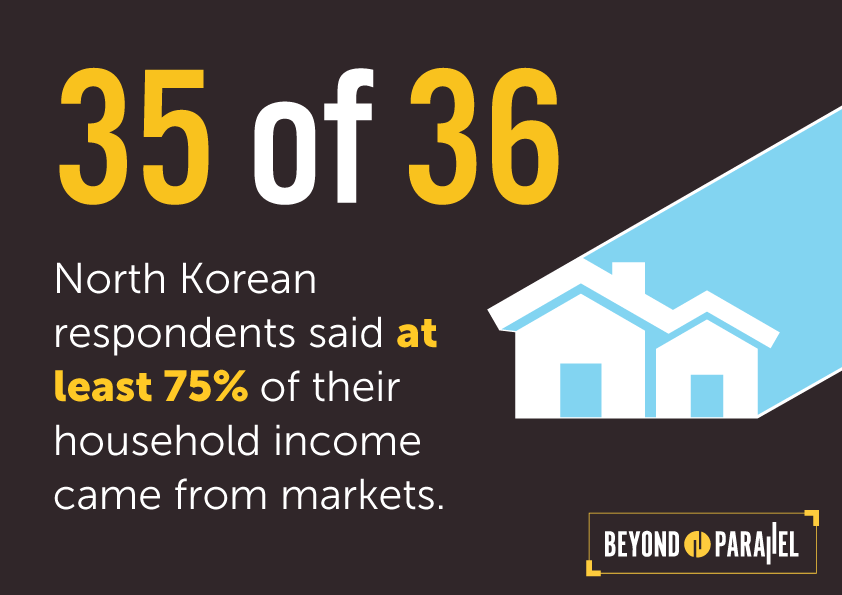
Income and Influence
21 of the 30 respondents who said the outside world had a greater influence on their lives than North Korean government decisions said they received almost all of their household income from markets. All of these respondents earned more than 75% of their household income from markets. Despite the statistical limitations of microsurvey results, it is not a large leap from these numbers to the conclusion that markets are substantively altering the traditional omnipotent impact of the North Korean government on its citizens’ economic lives.
Economic Impact? North Korean’s Percent of Household Income from Markets
| Factor with Larger Impact on Life | Nearly All Income from Markets | More than 75% of Income from Markets | About 50% to 70% of Income from Markets | Total Number of Respondents |
|---|---|---|---|---|
| North Korean Government Decisions | 5 | 0 | 1 | 6 |
| Influence from the outside world (i.e. goods and information) | 21 | 9 | 0 | 30 |
| Total Number of Respondents | 26 | 9 | 1 | 36 |
Gender Drive
Neither gender nor location appear to greatly influence the balance of market- or government-sourced household income for those respondents in the Beyond Parallel study. Of the 16 females interviewed, 13 (or 81%) of them said almost all of their household income came from markets. 13 of the 20 males, or 65%, who were interviewed reported almost all of their household income came from markets.
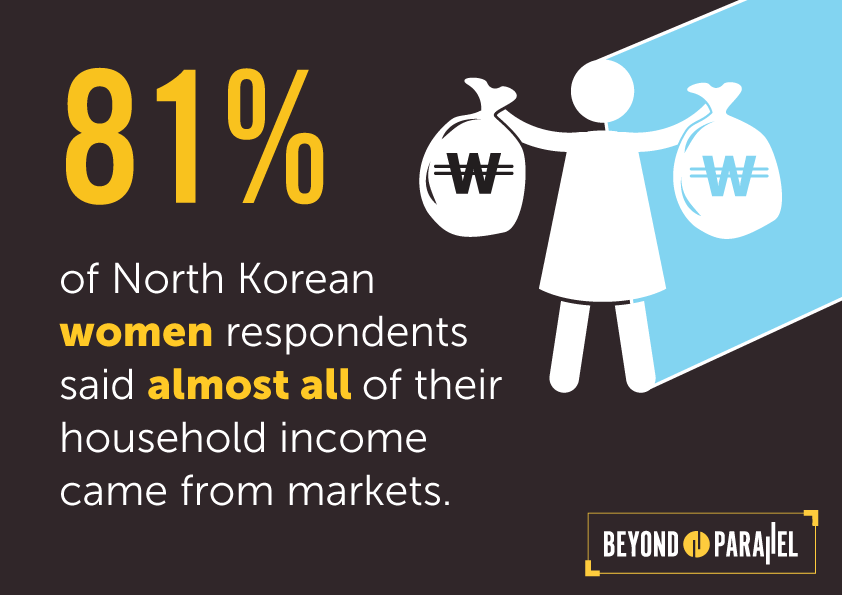
What Women Don’t Want
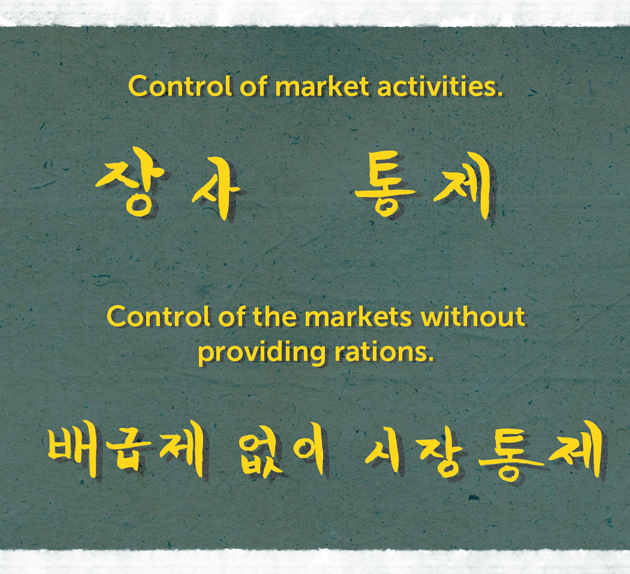
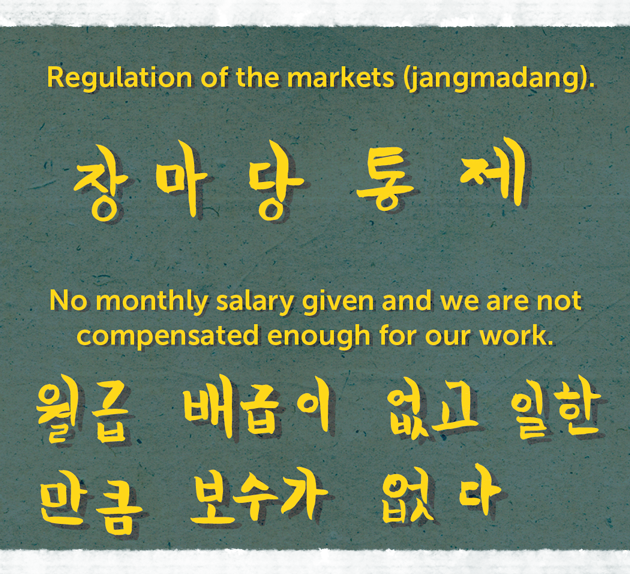
Market Penetration
Market income similar between China-North Korea border provinces and the rest of North Korea
Regionally, 12 of the 18 respondents living in provinces along the border with China said almost all of their household income came from markets. Similarly, 14 of the 18 respondents living in provinces in the rest of the country reported almost all of their household income came from markets. The only person to report that less than 75% of their household income came from the markets was from the capital city region of Pyongyang.
The geographic proximity to Chinese markets might lead one to intuitively surmise that northern North Korean provinces would have greater market activity. However, these responses corroborate other studies in indicating that market activity is prevalent throughout the country. In fact, a 2015 study of markets in North Korea using satellite imagery analysis found that formal market space in southern cities was actually larger than those located in the north.
While other studies on the geographic distribution of household income sourced from markets are not available, a 2016 Korea Development Institute (KDI) estimate of the North Korea’s per capita GDP (PPP basis) as of 2008 was relatively similar in all regions with the exception of the capital city. KDI’s maximum estimates showed that the per capita GDP in Pyongyang was possibly three times greater than in the rest of the country. KDI’s analysis also showed that the regional percentage of North Korean people aged 20-59 who were employed ranged between an average of 27.2 and 57.8. Here again it was found that the one outlier was the municipality of Pyongyang, with an average percentage of 46.9. 6
Methodology
Given the gravity of the consequences faced for expressing opinions and accessing foreign media in North Korea, the methodology of the interview project commissioned by Beyond Parallel was designed to account for the current conditions in the country and to protect all involved. In 2016, CSIS partnered with an organization that has a successful track record of conducting discrete and careful surveys in North Korea.
North Korea Survey: Sample Demographics

Beyond Parallel commissioned this organization to administer the questionnaire in eight provinces in North Korea. We talked with 36 men and women in walks of life ranging from laborers, doctors, homemakers, barbers, business presidents, to factory workers spanning in age from 28 to 80. The sampling method we used was non-probability, convenience sampling as accessibility was a prime consideration. There were no reported refusals to answer any of the questions posed by the administrators.
We began by asking North Koreans about the regime’s public distribution system, informal market and bartering activities, outside information, and unification. We inquired about events that drive their view of the government and foreign aid.
The fourth in our five-part series focused on respondents’ answers to the following question: What percentage of your household income is derived from the Jangmadang? 월 총수익 중 장마당 경영이 차지하는 비율이 어떻게 됩니까? “Jangmadang” refers to temporary markets that do not have official authorization from the state though some were more or less legalized from their status as black markets in 2003.
References
- Korea Institute for National Unification. September 2015. White Paper on Human Rights in North Korea 2015. Pages 325-326. www.kinu.or.kr ↩
- North Korean Public Perception on Unification 2015(북한주민 통일의식 2015 ). 2015. Institute for Peace and Unification Studies, Seoul National University (SNU). Page 247. ↩
- North Korean Public Perception on Unification 2015(북한주민 통일의식 2015 ). 2015. Institute for Peace and Unification Studies, Seoul National University (SNU). Pages 30-31. ↩
- Korea Institute for National Unification. September 2015. White Paper on Human Rights in North Korea 2015. Pages 327-330. www.kinu.or.kr ↩
- Kim, Hwa-soon. 2013. “Deciding Factors for the Types of Work of North Korean Citizens during the period of Market Liberalization.” Korea Institute for National Unification (KINU) Unification Policy Studies. Vol. 22, No. 1 Page 94. www.kinu.or.kr ↩
- Lee, Suk. December 2016. “How High is North Korea’s Real Employment and Income?” Korea Development Institute (KDI) Focus. No. 78, eng. www.kdi.re.kr ↩
